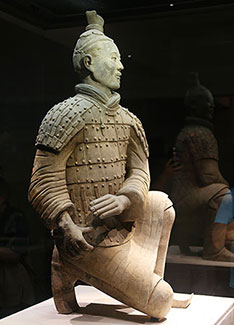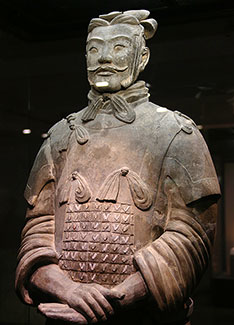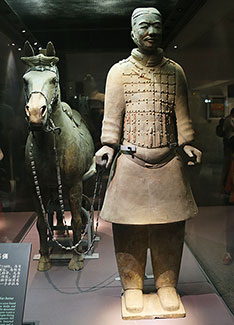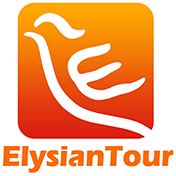
Terracotta Army
The incredible underground Terracotta Army was brought to public fortuitously in 1974 while some local peasants were digging a well for their irrigation system. They not only introduced this great archaeological site to the public, but also made explosive news all around the world. Listed as an UNESCO World Heritage Site, it is also considered by some to be the Eighth Wonder of the World for the exceptional technical and artistic quality. For years, the silent army has attracted travelers from all over the world whom admire this work of art.
Why build such an impressive underground army?
Ancient Chinese people strongly believed in the afterlife. From majestic Emperors to ordinary people, they believed in life after death and thus buried artifacts to use in the afterlife including treasures, transportation, livestock and even houses made into miniatures. In China, several ancient mausoleums of emperors from different dynasties were discovered with magnificent burial objects, treasures, even real people like servants, maids or eunuchs. Among all mausoleums known to people, the one of Qin Shi Huang (First Emperor) tops all others in terms of scale, secret construction and number of treasures. Amongst the treasures, the incredible underground Terra-cotta army consisting of life size replicas of soldiers built to protect the Emperor's reign in his afterlife.
About Qin Shihuang Emperor (First Emperor)
The owner of Terra-cotta Army, Emperor Shi-Huang, was quite a controversial figure in Chinese history because of the massive burden on the people who constructed the great archeological wonders of China, The Great Wall and Terra-cotta army. As the First Emperor of China, Shi-Huang unified the whole country for the first time in history after conquering the other six states. To better develop the nation's economy as well as better integrate different cultures, he standardized measurements, characters, currencies and built roads and canals, which all led to prosperity of the Qin Dynasty. The Great Wall was built at this time to stop nomadic groups from invading.
Museum of Terra-cotta Warriors and Horses:
At the site where the soldiers were discovered, a museum was built over the site to protect the national treasures, Museum of Terra-cotta Warriors and Horses. The clay soldiers and horses are in three pits, Pit 1, Pit 2 and Pit 3.
- Pit 1. The largest pit and most impressive one, with the most number of soldiers at over 6,000, displays the main battle formation consisted of vanguards, flanks, rear guards and horse-drawn chariots. With ten partition walls, the Army was built in eleven columns, each standing with strong faith shown from their facial expressions.
Best Shooting Angle: Northeast corner of the pit where displays a perfect panorama as well as details of the soldiers.
- Pit 2. Second largest pit with over 1,000 soldiers displays a smart battle formation, designed with consecutive attacks from kneeling archers and standing archers. And this is also where archers and cavalry men were discovered including the most frequently seen kneeling archer. The highlight of this pit is the five clay statues of kneeling archer, standing archer, middle ranking officer, high ranking officer (the General) displayed in five glass cases where people can get up close to observe the details of the clay figures.
Best Shooting Angle: Five warriors in the glass cases that you can get really close to shoot for details.
- Pit 3. This pit is the headquarters of the whole army, which can be told by its location and design. With only 68 soldiers and some animal bones discovered here, this is where the ceremonies were held, which is what ancient people used to do before each battle to tell their fortune in the coming battle.
Best Shooting Angle: Southeast corner of the pit where most of the soldiers in this pit can be seen with good light.
Representative Soldiers

Kneeling Archer
Characteristics:
- Only intact kneeling archer unearthed.
- Bun on left side to avoid pulling of his hair when he pulls his arrow from the arrow box carried on his back since most people are right handed.
- Specially made armor for the kneeling archer to bend over with upper rectangle pieces over the bottom ones on the top body while bottom ones over the upper ones on the lower part of body.
- Hand-made shoes with stiches all over the bottom to make it firm and solid. These hand-made shoes are still widely popular in the region today.
- Original color red still well preserved on his back.
High Ranking Officer (General)
Characteristics:
- Big in size of about 197 cm (6.5ft) to show the power of this powerful man
- Front edge of the shoes curve high up, the higher up, the higher rank the officer boasts
- Two knots on his head which is a symbol of high ranking
- Knots on his chest represent medals he won in their battle life
- Armor is shorter, made of smaller metal pieces with brighter color


Cavalryman
Characteristics:
- Horses without stirrups require cavalrymen to be taller and skinnier so that they can easily jump on the back of the horse
- Shorter armor without pauldrons allows easy and fast movements
Fun facts of the Terra-cotta Army:
- Then French President Chriac was amazed by the scale and artwork of the underground army and said: This could be the Eighth World Wonder, which was widely spreaded and became the most common way to introduce Terracotta Army.
- In 2006, a German fan of Terracotta Army who was so crazy about the 2,000-year old clay figures, made himself costumes, hair buns, even the plate each soldier stands came to the museum and jumped into the pit without anyone noticing and disguised as one of the soldiers until he moved a little and discovered by one of the tourists. This made breaking news in that year and afterwards the young man explained later all what he did was because of his great fondness of the underground army.
- You may find shocking to see the soldiers and horses broken into pieces and chariots almost gone, which was caused by a terrible fire set by the troop riots in the belief to defeat the First Emperor in his next life. That is also why the wooden chariots were all burned and destroyed, only petrified ruins are left to be seen.
- Only 1000 warriors and horses in Pit 1 can be seen since the rest were reburied right after they were discovered to help preserve the colors. As you may have heard, the original terra-cotta army was painted in vivid colors like real people. Soon after they were exposed to the air, the colors became oxidized and quickly faded which is why archeologists decided to bury them again to protect the colors, which is also why nearly the whole army in Pit 2 remains underground.
- A striking fact is that each soldier has a unique face as well as facial expression, figure, and hair style. Check out the detailed craft work of the different faces while you are there.
- Where have the weapons gone? A frequently asked question raised by travelers. Seen from the gestures of the soldiers, they were holding weapons, yet no weapons can be seen in the pits. After the fire, the wooden parts either burned or gradually rotted over the years leaving only the bronze parts which were collected for better preservation somewhere else in the museum.
- Heads got easily lost since they were made separately which is also why a lot of broken warriors are found without heads.
- Bodies were made hollow inside to avoid explosion during the baking process.
- The top reason why most foreign leaders choose Xi'an to be one of the must-go destination during their visit to China.
Bronze Chariots Drawn by Horses:
Found in a different pit close to the Mausoleum of the First Emperor, the bronze chariots won the crown of bronze artwork in Chinese history. Different from Terra-cotta Warriors, they are not life sized but half of the real size to protect the emperor's soul.

- Chariot: High Chariot, supposed to protect the second chariot behind. The charioteer holding horses ahead concentrates on the road condition ahead. The bronze umbrella can be used either for blocking sunshine or for shielding to protect the emperor under any sudden attack.
- Chariot: Security Chariot (also named Air-conditioned Chariot), with a bronze carriage, is for the emperor's soul to go out travelling. Admiration can be found on visitors faces viewing this exquisite and brilliant piece of artwork. Doors that open, windows of 1mm thick with ventilation holes, delicate gold and silver ornaments decorated, the workmanship of this chariot constantly renews archaeologists' understanding of ancient handicrafts.
Interesting to know:
Broken into over a thousand pieces when unearthed, it took archaeologists 8 years to put them back together so they could be placed for exhibition in the display hall.
 Useful Information:
Useful Information:
- Entrance Fee: CNY 150 from Mar. to Nov, CNY 120 from Dec. to Feb.
- Opening hours: 8:30AM-18:35PM from Mar. to Nov, 8:30AM-18:05PM from Dec. to Feb. Ticket service stops before 17:00 PM.
- How to get there: Take bus No. 306, 914, 915 at the Xi'an Railway Station.
- Wheel chair accessible: Yes, ramps are well built in the museum.









